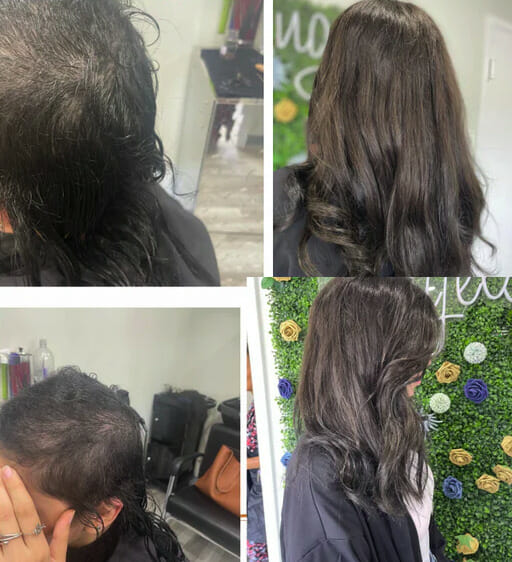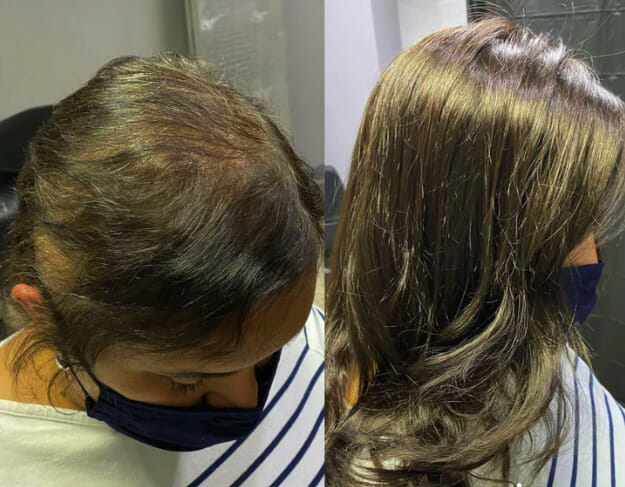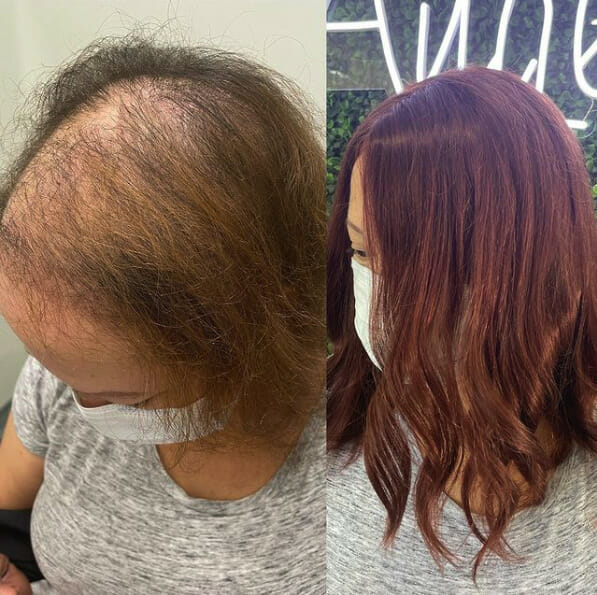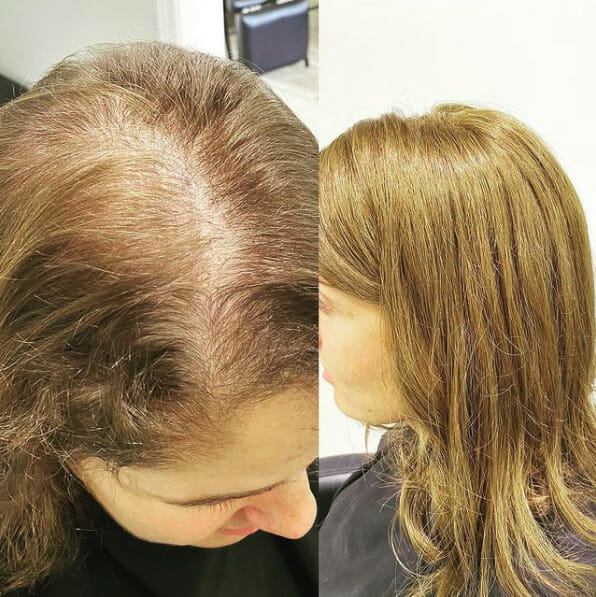Hair Loss and Trichotillomania Solutions by Noelle Salon
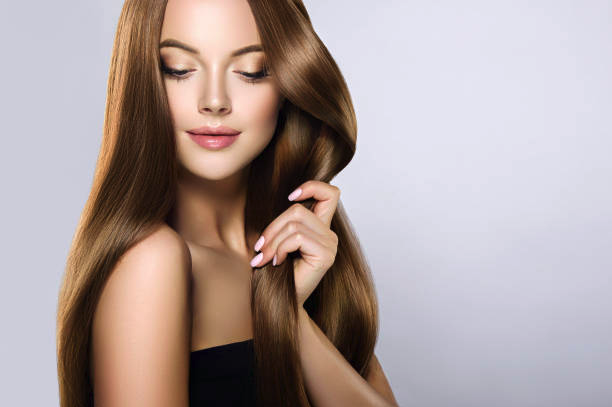
Noelle Salon is an industry leader with over 35 years of experience in hair coloring, hair straightening, hair extensions and hair loss solutions. Noelle Salon offers several approaches to managing female pattern baldness, balding spots, and hair loss. They also help manage conditions such as alopecia areata, traction alopecia, trichotillomania, and other conditions which cause thinning hair.
Noelle Salon focuses on providing hair growth techniques to clients with hair loss issues. They understand that hair care and hair extension maintenance, and practicing healthy hair habits are crucial to managing hair loss.
In this article, we’ll look at the causes of hair loss and how Noelle Salon manages hair loss and supports clients dealing with trichotillomania. We’ll also share tips on how to make your hair grow.
What causes hair loss?
Most people lose 50 to 100 hairs daily. They typically don’t notice because new strands of hair are growing simultaneously. It only becomes a problem when new hair doesn’t grow in to replace the shed hair, or your hair falls out beyond the average amount.
Hair loss happens as a result of one or more of these reasons:
- Age
- Alopecia areata
- Cancer treatment
- Childbirth
- Genetics (hereditary/based on family’s medical history)
- Hormonal imbalance
- Illness
- Medication
- Poor hair care
- Poor nutrition
- Scalp infection
- Stress
- Traction alopecia
- Trichotillomania
Age
As we get older, our rate of hair growth slows down. Eventually, our hair follicles stop producing hair, which causes hair thinning and dry hair strands. It also leads to loss of hair color (which causes white hair), hair shine, and receding hairline.
Alopecia Areata
Alopecia areata is a condition where your body’s immune system attacks the hair follicles, leading to hair loss. This autoimmune disease can cause you to lose hair on your scalp, eyebrows, eyelashes, inside your ears, in your nose, and anywhere there’s hair on your body. When dealing with alopecia areata, patients can suffer:
- Alopecia Totalis, where there’s a total hair loss on your scalp.
- Alopecia Universalis, marked by the complete hair loss on your scalp and entire body.
- Central Centrifugal Cicatricial Alopecia, characterized by scarring, inflammation, and permanent hair loss in the crown of your head.
Cancer treatment
If you’re undergoing radiation or chemotherapy for cancer, you may lose most or all your hair in a few weeks of beginning treatment. This is because of the consistent damage to the cells in your hair follicle. Research suggests patients wear a cooling cap to limit the effect of treatment on their hair.
Childbirth
Childbirth and pregnancy can trigger patchy hair loss because of hormones and stress. Some women experience hair loss during pregnancy, while for others, the damage to hair follicles happens some months after childbirth.
Genetics
Genetics is one of the most common factors that contribute to hair loss. The medical term for this condition is androgenetic alopecia. It is also known as hereditary hair loss or male or female pattern baldness.
Regardless of whatever you call it, this condition means you inherited genes that make your hair follicles shrink (in your early teens or later years) and stop producing hair. The first sign of female pattern hair loss is typically general thinning or a widening hair part. For men, male pattern baldness appears as a bald spot or receding hairline.
Hormonal Imbalance
PCOS (polycystic ovary syndrome) is one of the leading causes of hormonal imbalance. This condition causes cysts to grow on ovaries and other symptoms such as reduced hair growth or patchy hair loss due to infected hair follicles. Stopping birth control can also lead to hormonal imbalance, which can temporarily cause hair loss.
Medication
Medications for some health conditions have hair loss as a side effect. Similarly, illnesses and autoimmune diseases such as lupus can damage your hair follicles. However, if your medication seems to be causing hair loss, please speak to your doctor. It is dangerous to stop taking medicine without medical approval.
Poor Hair Care
It can be damaging if you consistently relax, perm, or color your hair without following up with proper hair care. This damage can eventually cause hair loss. Furthermore, if you frequently wear your hair in a tight ponytail or pull it back, it can contribute to temporary or permanent hair loss, also known as traction alopecia.
Poor Nutrition
Poor nutritional habits and a deficient diet can cause you to lose hair. Once you get your eating habits right, hair loss usually reverses. You can also fix your nutrient deficiency by taking supplements such as folic acid.
Scalp infection
A scalp infection tends to inflame parts of your scalp. Small scaly dots may appear on your scalp that feel somewhat swollen. These are infected hair stubs and may become bald spots if the infection isn’t treated early or correctly.
Stress
Stress is a widely known trigger for hair loss. You may notice your hair falling out or thinning during or after stressful periods in your life, such as divorce, job loss, recovery from illness or an operation, or a loved one’s death. Hair loss caused by stress is known as Telogen effluvium in medicine.
Stress sends a massive number of hair follicles into a resting phase, and those hairs fall out within several months. However, If there’s no other underlying cause, your hair often grows back once your body gets over the stress or the stressful event is over.
Trichotillomania
Trichotillomania is a mental disorder that causes a frequent overwhelming urge to pull out hair from your scalp, eyelashes, eyebrows, and other body parts. It requires treatment and care by trained medical professionals and hair specialists.
This disorder often causes bald patchy spots on the scalp after the hair has been pulled out. It can also lead to damage to hair follicle cells.
Hair loss may cause considerable distress to the person suffering from this condition because it interferes with their self-esteem, work, or social functionality.
How Noelle Salon Manages Trichotillomania
Trichotillomania (Trich) ranges from mild to manageable to chronically compulsive. Fortunately, there are treatment and management plans that can help people living with this disorder. At Noelle Salon, their approach to trichotillomania is BFRB, which stands for “Body-Focused Repetitive Behavior.”
This hair management system helps to create a barrier to help reduce the compulsive obsession with pulling out hair.
BFRB works with Comprehensive Behavioral Intervention for Tics (CBIT) and Habit Reversal Therapy to help people living with trichotillomania go into remission. The American Academy of Dermatology medically reviews these treatment systems. They have also been the subject of numerous peer-reviewed studies.
CBIT therapy utilizes sensory integration as a habit reversal approach and other CBIT responses to assist patients in managing behaviors like hair picking and pulling. This therapy combination explores the consequences, frequency, and triggers that cause trichotillomania behavior. This includes the people and environments where trich usually happens, the emotional and mental triggers, and physical feelings that occur before, during, and after pulling.
Noelle Salon has trained stylists that use BFRB hair management systems and hair extensions to help people dealing with trichotillomania. They never use glue or other damaging materials to attach hair extensions. Instead, they use revolutionary custom-designed Veila Hair Extensions. These easy maintenance extensions feel natural and comfortable and serve as a barrier against hair pulling.
How Noelle Salon Supports Clients Dealing With Trichotillomania
Trichotillomania is a challenging mental disorder to manage; it impacts the patient’s mental health, self-esteem, and general well-being. Most salons lack the proper knowledge and expertise to help people with this condition. However, Noelle Salon has been assisting clients in managing this condition for more than 30 years.
While clients are in treatment for trichotillomania, they offer gorgeous hair toppers or scalp prosthetics to ease the process. Unlike hair loss caused by fungal infections, female pattern baldness, or autoimmune diseases such as alopecia areata, trich is a disorder where hair follicles are forcefully physically removed.
Hence, Noelle Salon’s approach to supporting clients is focused on scalp care, allowing hair regrowth and the growth of stronger hair follicles. They also consider the need for hair coverage that will enable patients to handle their social or work life without worrying about their hair.
They give their clients a way to recover hair follicle cells from trichotillomania by reducing the stress of dealing with their natural hair.
Hair Styling with Trichotillomania
How Noelle Salon styles your hair depends on the disorder’s severity and scalp sensitivity. If the trich is mild, you can go for long extensions without worrying about triggering an episode.
However, styling your extensions short can be a better option if it’s chronic and your scalp is more than averagely sensitive. Whatever length you choose, you can flat iron or curl your hair extensions to suit your style.
Most importantly, they believe you should feel and look good while managing your condition.
How Noelle Salon Manages Hair Loss
Hair loss can happen to anyone for various reasons, such as aging, genetics, chemotherapy, stress, childbirth, hormonal imbalance, immune system disorders, etc.
The search for good wigs and hair extensions to manage hair loss can be challenging. At Noelle Salon, they offer custom-made extensions that suit the client’s lifestyle and personal style. They customize the wigs to ensure they are the right color, blend and fit for you.
They also teach you how to maintain your extensions and give tips for managing hair loss and making your hair grow.
How to Manage Hair Loss
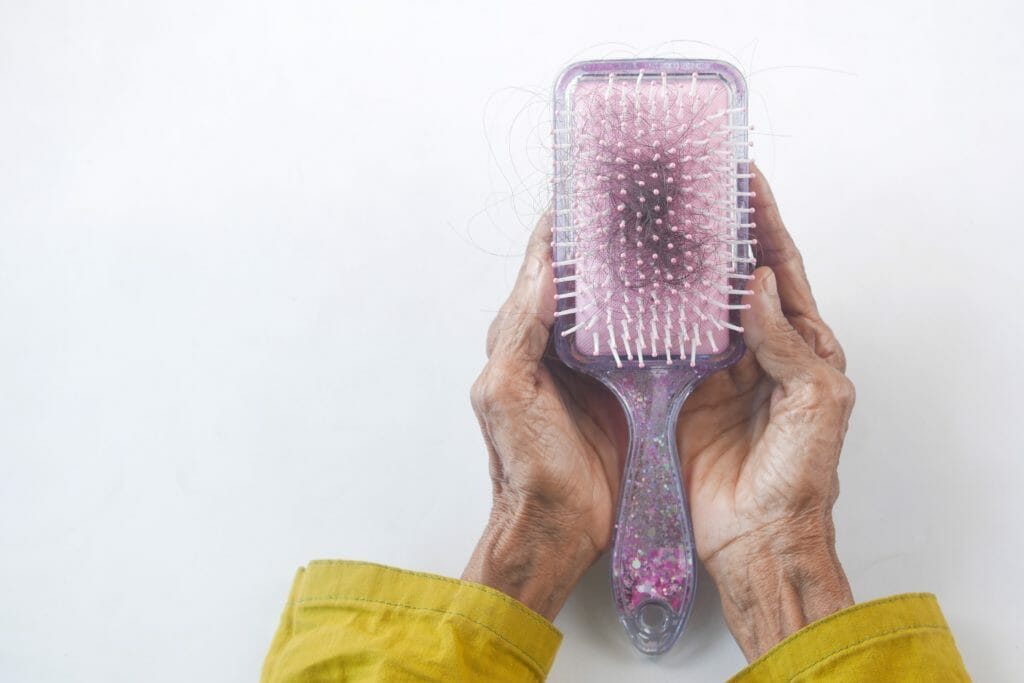
Photo Credit: Towfiqu Barbhuiya
Whether you are experiencing hair loss because of trichotillomania, female pattern baldness, trichotillomania, childbirth, or alopecia areata, a scalp massage will improve your hair growth. You can do the massage with or without essential oils.
Some women suffering hair loss may be worried about touching their heads, fearing it may further hinder them from growing hair. However, scalp massages are suitable for all types of hair. A scalp free from tension provides the right environment for hair to thrive and helps prevent hair loss.
Regardless of your hair type, whether thinning hair, healthy hair, fine hair, or textured hair, your scalp needs a massage. It also helps release the pressure most of us hold in our neck and head.
Consistency is critical when it comes to managing hair loss. Massaging your scalp at least 2 to 3 times per week would benefit you by helping repair your hair follicles. If you stick to this routine, an average of 1/4″ to 1/2″ hair growth can occur monthly and probably double over time.
To further promote hair growth, you can take hair growth supplements such as Nutrafol and use hair products like Nutrafol Growth Activator Serum for your massages. You can also use regular essential oils like rosemary or lavender combined with carrier oils like castor oil, olive oil, or jojoba oil. Speaking to a hair expert or board-certified dermatologist is advisable to avoid adverse side effects before using any of these oils.
Finally, avoid products that claim to make hair grow faster overnight. Your hair grows healthier when you follow advice from a healthcare professional or an experienced certified hair stylist like those at Noelle Salon.
Conclusion
Noelle Salon’s hair loss and trichotillomania management system is based on compassionate treatment through therapy and hair care. They combine BFRB (Body-Focused Repetitive Behavior) with CBIT (Comprehensive Behavioral Intervention for Tics) and Habit Reversal Therapy to help people living with trichotillomania. They also help their clients aesthetically by providing customized hair extensions to help them manage their hair loss and ensure their hair grows with minimal worries.
So don’t wait – start your journey to growing hair and keeping it healthy with Noelle Salon.
FAQs
How do I select the best hair extensions for hair loss?
Noelle Salon offers a variety of hair extension styles and colors. However, they don’t use clip-in or tape-in hair extensions because they often lead to damaged hair. They use Veila Hair Extensions that are applied without glue, tape, or sewing threads. The hair is carefully pulled through the tiny attachment holes in the direction of your hair growth. This way, there’s less tension, unlike sew-in or tape-in hair extensions, and it can easily blend with your hair.
Their hair extensions make you look fantastic with minimal discomfort, tension, and low maintenance.
How long does it take for hair to grow back after trich hair loss?
Hair often regrows after trichotillomania hair loss between 1-6 years, depending on the severity of the case. Nonetheless, new hair growth becomes improbable when a patient has been pulling their hair for over 20 years.
How do hair extensions help trichotillomania?
People living with trich often need a way to give their hair a growing phase, so damaged hair follicles can recover from the stress of being pulled out. Hair extensions offer a way to have full hair while your scalp is healing.
What do I need to know about hair loss solutions?
With Alopecia Areata, fungal infections, and other autoimmune diseases, thinning hair by Trichotillomania removes hair follicles by physical means. At Noelle Salon, we cover the various approaches to hair solutions to treat hair loss, female pattern baldness, balding spots, and other conditions to which you lose hair. At Noelle Salon, they focus on hair growth techniques.
Hair systems and hair extension maintenance is part of the journey while wearing them. For Trichotillomania, as our hair grows they both will loosen, and service is required. The difference between a hair system and hair extensions for Trichotillomania clients varies based on the location of hair loss.

